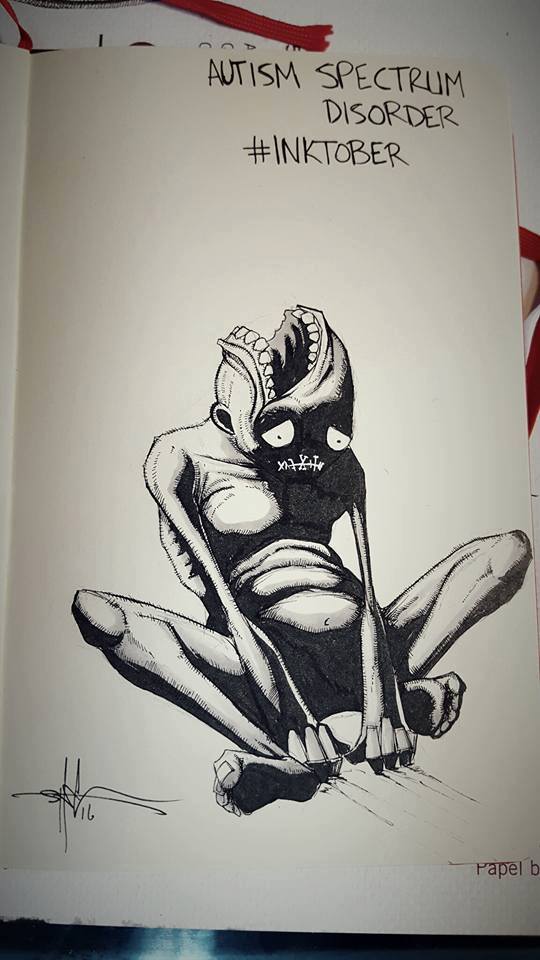Autism, masking, and personal experience
#EgoTime
In 2016, Shawn Coss, illustrator artist, participated in the #Inktober event (where you have to draw ink drawings for a month, one per day, during October).
He decides to focus his drawings on mental illnesses and disorders.
Why am I sharing this with you?
You read the first hashtag, so you guessed it: to talk about me (once will not hurt).
One of these drawings has always been important to me when I saw it at that time, especially since I was in the middle of my autism diagnosis (which continues today with therapy and “reboot” of my mental situation after a lot of issues).
In fact, this concept of having the impossibility of expressing oneself by voice, but having a brain that screams with a need for expression, may seem paradoxical, but it is one of the typical traits of autism.
Depending on the severity of autistic traits (more often called “ASD” for “Autism Spectrum Disorders”), some autistic people are able to express themselves verbally, or not.
And for those who succeed, it’s a really tough mission.
It’s even worse for people who “accumulate” particularities (epilepsy, ADHD, high potential, depression, psychoses, schizophrenia, and so many other neuro-atypicals traits, pathological or not), for whom it’s sometimes an impossible mission.
In general, for most human beings, there is a need for an important social and emotional connection (it’s biological: it’s a survival technique, humanity only survived because it lives in strongly bonded communities).
However, for autistic people, this need for social bonds is altered, sometimes completely “cut off”, by neurological changes that prevent certain social interactions (source: Thomas Bourgeron - “Des gènes, des synapses, des autismes”).
However, autistic people do not always need to be in total isolation. It can happen for some, but not all of them.
There are what the media call “high-functioning autism” (a kind of popular summary of “high level of social and cognitive potential compared to more severe forms of autism”, I admit I don’t really like this definition, but it serves the subject in some cases) who are able to socially interact with less difficulty than other autistic people (and of which I am one, if you have ever met me in person).
These “social” autistic persons are among those for whom the difficulty of experiencing autism is totally different, because it implies that they can communicate and exchange, and that autism, therefore, is less visible. And by this strong social need, these autistic people do what is called “masking”, in order to be able to maintain this link.
“Masking” is (to sum it up) a method that autistic people use to compensate for their social difficulties by constantly modifying their behavior according to the people they talk to, sometimes even going as far as a form of mimicry (taking up postures, gestures, expressions, or even… their accent!), all in the hope of keeping in touch with the person.
This “masking” involves a lot of constraints:
- You have to keep your eyes on the person(s), and for autistic people, keeping eye contact with someone is sometimes very difficult
- You must be in permanent vigilance of your own body, behavior, intonation, speech, etc.
- And it’s mandatory that you constantly check that you are not disturbing or making the person uncomfortable, so you have to double your efforts to analyze the attitude of the other, a very difficult thing because autistic people have a lot of shortcomings in this area, sometimes even a real incapacity
The two main consequences are emotional exhaustion, and relational breakdown because precisely this fatigue alters our behavior.
Since most autistic people have this “innate” trait of having a need for connection but a difficulty or inability (variable according to the people) to communicate in a “standard” way with those around them, imagine how much this “sewn mouth” (like in the drawing by Shawn Coss) prevents keeping a link, and how the bran scream can exhaust the autistic person who is barely able to keep a link that is essential for them.
Now, add to all of these difficulties things like depression (been there, done that). This mental and emotional state inevitably involves an increase in the difficulty of expression, and it can come to a stage where one simply no longer communicates.
On a personal note, for years, I’ve slowed down on conferences for example, I’ve stopped doing technical video streaming, I’ve even stopped giving tech trainings, because I have no more energy, I’ve spent too much, and above all, life in general is very difficult, especially if you add in the eco-anxiety that my generation is undergoing because of the climate crisis, and the various social, political and economic crises, and you have everything needed for a person.
I find myself like in this image, like many other autistic people of my generation: an enormous need to express myself, but an inability to do so.
I don’t know what the moral of this post may be, but wherever you are, whoever you meet, I suggest you take into account that most people are not mean to you, sometimes they are just overwhelmed by everything what’s around them, their brain is screaming, and they just can’t tell you, because they don’t have that ability anymore.
